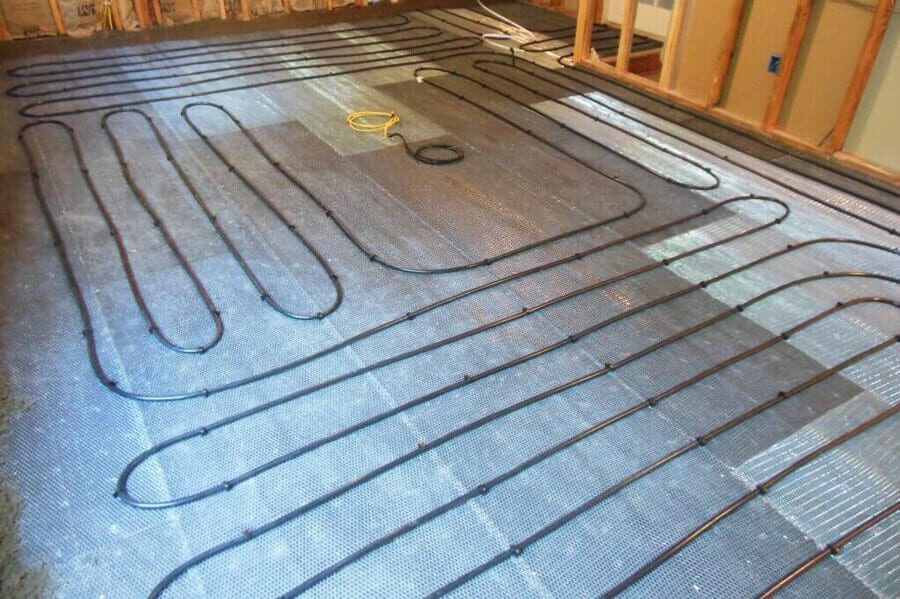Today’s homeowners want to not only stay warm throughout the cold winter months, but also to maintain a level of comfort in a responsible, efficient way. This has become even more important as the cost of heating fuel continues to rise, and right along with it the questions about how ethical and sustainable many of these fuels really are.
As an answer to the call, heating systems of all kinds are growing more efficient, saving you money and keeping you comfy through the chilliest of days. Demand has certainly driven improvement and ingenuity, and that’s a good thing!
This demand has also created innovate heating methods that step outside the box just a bit. As a perfect example, let’s take a closer look at radiant heat.
What Is Radiant Heat?
For decades now, heat has been primarily delivered in one of a few ways: forced hot air (less in vogue these days because of inefficiency), radiators, or hot water through baseboards. Supplemental heat sources have certainly been popular as well (wood and pellet stoves, fireplaces, etc.).
So, what exactly is radiant heat, and what place does it have in homes today?
Well, you really have two primary options: hydronic (water) radiant heat, or electric. Electric is typically reserved for heating smaller spaces, however, so we are going to focus instead on the more comprehensive and practical hydronic option.
Hydronic radiant heat is a system of tubing within your floor that carries hot water. It warms the entire substrate around it, offering an even, pleasant, consistent heat source. It also is remarkably efficient (we’ll explain exactly why in more detail below).
Interestingly enough, the concept of radiant heat is nothing new. In fact, different variations have been in existence for thousands of years, celebrating the value of heating both walls and floors. What is new, however, is the level of efficiency that is possible by simply modernizing and standardizing a fantastic idea.
How Is Radiant Heat Installed?
This depends on the system you choose and the type of flooring you have.
In general, whether your radiant heat is hydronic (water-based) or electric, it includes a network of either tubing or electric cables within your floor.
A “wet installation” involves embedding your system within a concrete slab below your floor. This is most common for ranch-style homes that are built on a slab without a basement below. The concrete provides a nice, convection-effect, although it does require a consistently higher temperature to heat the concrete (you can’t simply turn your heat up and down since it takes the slab a long time to warm and cool).
“Dry installations” take concrete out of the equation, and are installed below the subfloor. Some options, like Warmboard, are installed inside a superconductive material as well, supercharging the efficiency and allowing for a much quicker warm-up time.
Speaking of Warmboard and hydronic radiant heat installation, this brief video offers a nice, concise look at the installation and benefits. You might find it interesting!
Why Is Radiant Heat So Efficient?
Whether you have a wet or dry installation, the benefits are largely the same:
- Even, consistent heat
- Because the substrate itself is consistently warmed, and will retain/give off the heat for some time, these systems can be as much as 30% more efficient
- Radiant warmth is very pleasant, much like the feeling of approaching a warm stovetop on a cold day
In a nutshell, hydronic radiant heat offers a high level of efficiency because it wastes, or loses, so little heat.
Did you know…
Radiant heat is also a wonderful alternative for those with allergy sensitivities. Because the warmth isn’t blown around a room and carries no dust, it is very hypoallergenic.
Can You Install Radiant Heat Under Any Type of Flooring?
Almost!
We’ve installed radiant systems under diverse flooring materials, including:
- Hardwood Floors
- Tile
- Stone
- Within concrete
If you are building from scratch, the key is to talk with your building professional about which type of floor will best complement the type of system you have. As long as the system is installed correctly, however, it will work well in really any space and under nearly any surface.
Is Radiant Heat More Expensive Than Traditional Systems?
Yes, radiant heat is typically more expensive than forced hot air and baseboard heating systems. The cost difference isn’t quite as drastic, however, if you are installing a system in new construction. If you are tearing up and replacing floors in an existing home, on other hand, it does add significantly to the cost.
The important thing here is to consider the long-term investment. Radiant heat may cost more initially, but it offers substantial savings over time. If this is a long-term home, the return can definitely pay you back.
Is Radiant Heat Right for You?
We recommend talking to a professional, experienced building and remodeling company during your next home improvement adventure. Discuss the pros and cons, and which type of radiant system might best meet your needs.
We’re confident that you won’t regret the decision. And, the first time you feel a warm floor under your feet while the snow is falling outside, well, you’ll never want to go back.

